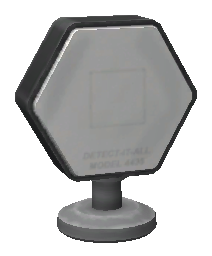Difference between revisions of "M4435 Narrow-Band Scanner"
m (Blanked the page) |
m (Reverted edits by Rocketing Rudolph (talk) to last revision by ArnePeirs) |
||
| Line 1: | Line 1: | ||
| + | {{User:BobBot/created part}} | ||
| + | {{:M4435 Narrow-Band Scanner/Box}} | ||
| + | The '''M4435 Narrow-Band Scanner''' is a part introduced in version 1.0. | ||
| + | |||
| + | == Product description == | ||
| + | {{Quote | ||
| + | |Ideal for surveying potential landing sites, this scanner provides detailed information about the planet or moon that it orbits, though this data is limited to the spot directly below the scanner. | ||
| + | |Experimental Engineering Group}} | ||
| + | |||
| + | == Usage == | ||
| + | The '''M4435 Narrow-Band Scanner''' provides high resolution surface scans of the celestial body it orbits. As the description implies, it can only scan a very small area directly below its position. Its purpose is mainly to locate areas with a high concentration of [[Ore|ore]], in order to find spots with the highest yield possible for mining operations. Since it delivers a much higher accuracy than the [[M700 Survey Scanner]], it is reasonable to scan areas with high resource concentrations previously identified by a survey scan. | ||
| + | |||
| + | Though not a requirement, for optimal results it is often desirable to place a satellite equipped with a M4435 in a polar orbit. This allows the scanner to eventually pass over and scan any desired portion of the planet or moon. Because the [[M700 Survey Scanner]] also needs a polar orbit and you need to conduct a scan with one to use the M4435, it is wise to mount both modules on one satellite. | ||
| + | |||
| + | == Requirements == | ||
| + | The '''M4435 Narrow-Band Scanner''' requires a completed orbital survey (see the [[M700 Survey Scanner]]) otherwise no ore data can be generated. | ||
| + | |||
| + | == Changes == | ||
| + | ;[[1.2]] | ||
| + | * Added [[KerbNet]] access | ||
| + | ;[[1.0]] | ||
| + | * Initial release | ||
| + | |||
| + | {{Parts}} | ||
Revision as of 18:25, 17 March 2017
| M4435 Narrow-Band Scanner | ||
| Scanner by Experimental Engineering Group | ||
| Radial size | Tiny, Radial mounted | |
| Cost | (total) | 1 000.00 |
| Mass | (total) | 0.100 t |
| Drag | 0.2 | |
| Max. Temp. | 2000 K | |
| Impact Tolerance | 7 m/s | |
| Research | | |
| Unlock cost | 3 000 | |
| Since version | 1.0 | |
| Part configuration | OrbitalScanner.cfg | |
| Mode | Surface | |
| Resource | Ore | |
| Max. Altitude | 500 000 m | |
| Field of View | (min) | 5 ° |
| (max) | 90 ° | |
| Anomaly detection | 0 % | |
| Enhanceable | Yes | |
| Mode | Resources | |
| Packed volume | 600 l | |
The M4435 Narrow-Band Scanner is a part introduced in version 1.0.
Product description
| “ | Ideal for surveying potential landing sites, this scanner provides detailed information about the planet or moon that it orbits, though this data is limited to the spot directly below the scanner. — Experimental Engineering Group |
” |
Usage
The M4435 Narrow-Band Scanner provides high resolution surface scans of the celestial body it orbits. As the description implies, it can only scan a very small area directly below its position. Its purpose is mainly to locate areas with a high concentration of ore, in order to find spots with the highest yield possible for mining operations. Since it delivers a much higher accuracy than the M700 Survey Scanner, it is reasonable to scan areas with high resource concentrations previously identified by a survey scan.
Though not a requirement, for optimal results it is often desirable to place a satellite equipped with a M4435 in a polar orbit. This allows the scanner to eventually pass over and scan any desired portion of the planet or moon. Because the M700 Survey Scanner also needs a polar orbit and you need to conduct a scan with one to use the M4435, it is wise to mount both modules on one satellite.
Requirements
The M4435 Narrow-Band Scanner requires a completed orbital survey (see the M700 Survey Scanner) otherwise no ore data can be generated.
Changes
- Added KerbNet access
- Initial release
